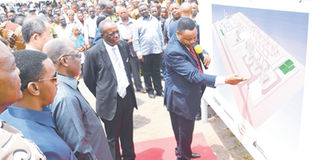Why Magufuli's power dream may elude him

Tanesco managing director Felchesmi Mramba explains the finer points of the Kinyerezi II Power Plant as shown on an architectural drawing to President John Magufuli in the outskirts of Dar es Salaam yesterday.
Looking on are, left, Dar es Salaam Regional Commissioner Paul Makonda and the Energy minister Prof Sospeter Muhongo. PHOTO | STATE HOUSE
What you need to know:
The President inaugurated yesterday the Kinyerezi II power plant in the outskirts of Dar es Salaam while bemoaning the exorbitant price that tax payers were shouldering to pay the private power producers.
Dar es Salaam. President John Magufuli’s dream to provide cheap and reliable power supply may outlive his tenure in office due to the costly electricity supply contracts that Tanesco entered with independent power producers (IPPs).
The President inaugurated yesterday the Kinyerezi II power plant in the outskirts of Dar es Salaam while bemoaning the exorbitant price that tax payers were shouldering to pay the private power producers.
As the government brings to fruition some of the state owned gas-power generation projects, it however remains stark clear that consumers will continue to pay for the high electricity tariff to service the long-term IPPs contracts, some running for over 15 years.
Tanesco’s payment of nearly Sh20 billion every month in capacity charges alone to four main IPPs, means that the relief expected from the launch of the Kinyerezi I last year and Kinyerezi II gas-power plants yesterday would not reflect any time soon on consumers.
The IPPs, Songas, Aggreko, IPTL and Symbion (formerly Dowans or Richmond) were contracted at different times to generate electricity which they then sold to Tanesco via the expensive contracts. Tanesco pays for the power supplied as well as the capacity charges that are paid even when no production is done.
Reports show that Tanesco pays Songas a monthly capacity charge of Sh8.5 billion, Aggreko Sh1.6 billion and IPTL Sh4.3 billion (even though some MPs have insisted the amount paid to IPTL is $4 million every month that works to about Sh8 billion).
IPTL was commissioned to generate 100MW, Songas (180MW), and Aggreko (50MW), mostly during the two-decade long power supply crisis. Their contracts were recently renewed and will remain in force for more than 10 years.
The significance of yesterday’s launch of the construction of Kinyerezi II plant is the fact that Tanesco would significantly cut down the cost of buying the expensive energy from the IPPs with the improvement of its own cheap sources of energy.
Kinyerezi I (150MW) costing $183 million (Sh400bn) was launched in October last year by Former President Jakaya Kikwete while Kinyerezi II which President Magufuli launched is expected to generate 240MW by May this year. The government released Sh120 billion recently to start the construction of Kinyerezi II while the balance of Sh292 billion will be funded by the Japanese government.
Tanesco’s financial position is weighed in badly by the mounting debts owed to the four IPPs, a burden that made President Magufuli declare that he would not wish to see the power utility firm enter into similar agreements in future.
The President stopped at declaring an end to the contracts, lamenting that their joint cost was debilitating. He singled out the government’s long running battle with IPTL for mention as one of the sector’s headache.
“We must in the near future get rid of the tendency of hiring private power producers. We are tired of doing business with some rogue investors who made us pay capacity charges while leaving our people pay high price for power. We are burdening our people unnecessarily,” he said.
He added: “We must reach a point where we’ll get rid of unreliable power sources and power from contracted producers...that’s why we always hear of countless problems in the sector like the IPTL because we heavily relied on independent producers.”
Earlier this month, it was revealed that more than two-thirds of Tanesco’s debt standing at Sh551 billion is owed to the private power producers and some oil and lubricant suppliers.
In documents filed with the Energy and Water Regulatory Authority (Ewura), Tanesco indicated it owed IPTL Sh125.37 billion, Songas Sh214.84 billion and Pan African Energy—which supplies natural gas for power generation Sh172.15 billion.
Other big creditors include Aggreko International and Symbion Power who are owed Sh174.26 billion for emergency power purchase.
Cumulatively, Tanesco’s debt portfolio means the agency is perpetually reliant on the Treasury to bail it out of its financial crisis, with little room therefore to cut down on pricing to benefit the already overburdened consumers. That is why it was surprising that the agency recently filed an application with Ewura to approve a tariff reduction of 1.1 per cent effective from April 1 this year, and a further cut of 7.9 per cent effective from January 1, 2017.
Sources have, however, intimated that the application was in compliance with a government directive as Tanesco was currently selling its power at a loss. The government has said it wants up to 75 per cent of Tanzanians connected over the next decade, up from 40 per cent. Lowering connection fees and tariff is seen as a way to woo more low end consumers.
But analysts have over the years warned that political interference in the running of Tanesco was a stumbling block in plans to turn around the loss making corporation. The World Bank and the International Monetary Fund (IMF) are among bodies that have called for higher tariffs in Tanesco to break even.




